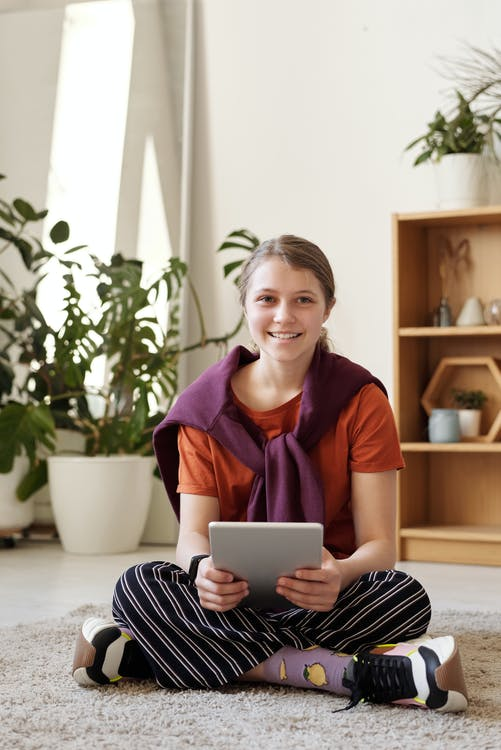How Can Online School Help Students Overcome Anxiety?

According to a recent study published in 2021, anxiety and depression are on the rise among students in the UK. When students are overworked in school and provided with little to no personal and social support, they develop high levels of stress, which can turn into anxiety and even depression. These serious mental health concerns must not be dismissed under any circumstances.
Academic stress is very different from routine stress. It stems from high-pressure studies, unsupportive teachers, potential bullying/discrimination/peer pressure/harassment in school, and a low sense of self-worth.
In recent years, the online schooling model has stood out for its focus on student mental health. Also known as flexible learning, online learning gives students some much-needed leeway, allowing them to establish and consistently maintain a healthy school-life balance. At the same time, there’s a strict focus on academic growth. However, it doesn’t come at the cost of student mental health.
In this blog, we’ll dig deeper. How does online school achieve this balance? Moreover, how does it help students who are struggling with stress and anxiety? Keep reading.
1. Flexible Learning

Learning should never be rigid at any academic stage, primary school, secondary school, IGCSEs, or A Levels. Students must be granted some flexibility that can be utilised for healthy afterschool activities like playing sports, spending time with friends, going on adventures, traveling, volunteering, developing new skills, exploring new hobbies and interests, and so on. Students crave personal and social growth.
In many conventional schools, this isn’t prioritised. Instead, there’s a strong and sole focus on academic growth. When students don’t enjoy fun activities during and after school, they begin to feel anxious and worn out.
The online schooling model makes use of the concept of flexible learning. Students don’t commute to/from school, nor do they spend an unnecessarily long amount of time in school. Their classes are focused, well-timed, and balanced.
When students return home from school, they can make time for the aforementioned activities. They also retain higher energy levels since these aren’t depleted shuffling in and out of classrooms in a conventional schooling setting. Moreover, students also have ample fun at school!
Today, most online schools have a razor-sharp focus on academic growth. At the same time, teachers plan fun, engaging, stimulating, and interactive activities, games, group presentations, and exercises to help students enjoy themselves and learn at the same time. This plays a big role in reducing anxiety levels.
2. One-on-One Success Coaching and Pastoral Support

The only schooling model is known for its focus on empathy-based learning. Students aren’t judged or rebuked. Instead, their shortcomings are understood and carefully worked on. Many conventional teachers verbally and often even physically scold students, making them anxious.
Students feel frightened of their teachers and dread going to school. It becomes very difficult for parents to figure out what’s happening, especially if their children are young and not prone to opening up about what they’re experiencing in school. Children often feel embarrassed about what’s happening to them, making them feel nervous about informing their parents.
The online schooling model veers away from this approach. Students attend engaging lessons taught by empathetic, caring, considerate, and supportive MA/MSc/PhD teachers. Their unique concerns and queries are promptly and assiduously addressed.
Cambridge Home School Online, one of the top online schools across the globe, provides one-on-one success coaching and pastoral support to each student. Their school counsellors work closely with each student to provide the guidance, direction, encouragement, motivation, reassurance, and advice they need.
3. Close Monitoring
Online schools have a low student-teacher ratio; roughly 8–10 students are taught in a single classroom. In comparison, most conventional schools teach 25, 30, and even 35 students in one classroom. As a result, students don’t receive one-on-one attention from their teachers.
Additionally, the risk of school bullying, peer pressure, harassment, discrimination, racism, and abuse increases. There are too many students present in the class and not enough teachers. Student interactions go unnoticed, which means any unpleasant experience a student may have is between them and the perpetrator. Students sitting around them may notice what’s happening. However, the teacher rarely identifies these instances.
In most online schools today, classes are closely monitored. Teachers don’t have any difficulty monitoring 8–10 students. They closely track each pupil’s learning strengths, weaknesses, and patterns. However, they also track their behaviour in class and their interaction with their peers. If a student misbehaves with another, they’re offered a warning and/or removed from the classroom. Their parents may also be involved depending on the severity of their speech/action.
This practice protects students from being bullied in class. In most cases, school bullying is the leading cause of the development of anxiety. Students who are attacked by their peers (verbally, physically, and even emotionally) develop anxiety, which can snowball into a more serious mental health issue if it’s not promptly identified and addressed.
Online schools protect students and further build them up through affirmative teaching. Students become curious, confident, and capable learners who explore different opportunities in life without backing down.






